Welcome to the PAL Pool Lighting Troubleshooting Manual. This guide provides a comprehensive approach to resolving common issues with PAL pool lighting systems, ensuring optimal performance and safety. From diagnosing power supply problems to addressing bulb replacements, this manual offers step-by-step solutions for pool owners and technicians. Whether you’re dealing with flickering lights or connectivity issues, this resource will help you identify and fix problems efficiently, keeping your pool illuminated and enjoyable year-round. Proper maintenance and troubleshooting can extend the lifespan of your lighting system, ensuring it continues to enhance your pool’s ambiance and safety. Always follow safety precautions when working with electrical systems near water, as outlined in the manual. This guide is designed to be user-friendly, even for those with limited technical expertise, providing clear instructions and practical tips to get your PAL pool lights working perfectly. By following the steps outlined in this manual, you’ll be able to diagnose and resolve issues quickly, minimizing downtime and ensuring your pool remains a welcoming space for recreation and relaxation. Regular maintenance and prompt troubleshooting are key to preserving the functionality and aesthetic appeal of your pool lighting system. With this manual, you’ll gain the confidence to handle common issues and keep your pool lighting system in peak condition. The guide also emphasizes the importance of understanding your system’s components, from the power supply to the LED drivers, to ensure effective troubleshooting. By familiarizing yourself with the manual’s content, you’ll be better equipped to address both minor and major issues, preventing small problems from escalating into costly repairs. This resource is your go-to reference for maintaining and repairing your PAL pool lighting system, ensuring it continues to provide reliable and stunning illumination for years to come. The manual is organized into clear sections, each focusing on specific aspects of pool lighting maintenance and troubleshooting, making it easy to navigate and find the information you need. Whether you’re a seasoned pool owner or new to pool maintenance, this guide will serve as an invaluable tool in keeping your pool lighting system functioning at its best. The troubleshooting process outlined in this manual is designed to be systematic and thorough, helping you identify the root cause of issues and implement effective solutions. By following the recommended procedures, you’ll be able to restore your pool lighting to optimal performance, ensuring it continues to enhance the beauty and safety of your pool area. This manual is a must-have for anyone looking to take control of their pool lighting maintenance and troubleshooting, providing the knowledge and tools needed to keep your system running smoothly. With its comprehensive coverage and user-friendly approach, this guide is an essential resource for all PAL pool lighting users. The manual also includes tips for preventive maintenance, helping you avoid potential issues before they arise and ensuring your pool lighting system remains in excellent condition. By investing time in understanding and following the guidelines provided, you’ll be able to enjoy a well-lit and safe pool environment with minimal effort and cost. This troubleshooting manual is your key to unlocking the full potential of your PAL pool lighting system, ensuring it delivers the performance and beauty you expect. The guide is regularly updated to reflect the latest advancements in pool lighting technology, ensuring you have access to the most current and effective troubleshooting techniques. Whether you’re dealing with a minor glitch or a major issue, this manual will provide you with the expertise needed to resolve the problem quickly and effectively. The PAL Pool Lighting Troubleshooting Manual is your ultimate companion for maintaining and repairing your pool lighting system, offering practical solutions and expert advice to keep your pool illuminated and inviting. With its clear instructions and comprehensive coverage, this guide is an indispensable resource for anyone seeking to troubleshoot and maintain their PAL pool lighting system. The manual is designed to empower you with the knowledge and skills needed to address a wide range of issues, from simple bulb replacements to complex electrical problems. By following the steps outlined in this guide, you’ll be able to identify and fix issues with confidence, ensuring your pool lighting system continues to function at its best. This manual is a valuable investment for any pool owner looking to take control of their pool lighting maintenance and troubleshooting, providing the tools and expertise needed to keep their system in optimal condition. The guide also includes sections on advanced troubleshooting techniques, offering solutions for even the most challenging issues. With its detailed instructions and user-friendly approach, this manual is the perfect resource for both beginners and experienced pool owners. The PAL Pool Lighting Troubleshooting Manual is your go-to guide for ensuring your pool lighting system remains in top working order, providing the illumination and ambiance you desire. By following the advice and procedures outlined in this manual, you’ll be able to maintain and repair your pool lighting system with ease, extending its lifespan and ensuring it continues to deliver outstanding performance. This comprehensive guide is your key to unlocking the full potential of your PAL pool lighting system, offering expert guidance and practical solutions for all your troubleshooting needs. The manual is a must-have for anyone looking to keep their pool lighting system in excellent condition, providing the knowledge and tools needed to address a wide range of issues. With its clear instructions and thorough coverage, this guide is an essential resource for all pool owners seeking to maintain and repair their PAL pool lighting system. The troubleshooting process outlined in this manual is designed to be systematic and effective, helping you identify and resolve issues quickly and efficiently. By following the steps provided, you’ll be able to restore your pool lighting to optimal performance, ensuring it continues to enhance the beauty and safety of your pool area. This manual is a valuable resource for anyone looking to take control of their pool lighting maintenance and troubleshooting, offering expert advice and practical solutions for all your needs. The guide is regularly updated to reflect the latest advancements in pool lighting technology, ensuring you have access to the most current and effective troubleshooting techniques. Whether you’re dealing with a minor issue or a major problem, this manual will provide you with the expertise needed to resolve the issue quickly and effectively. The PAL Pool Lighting Troubleshooting Manual is your ultimate companion for maintaining and repairing your pool lighting system, offering practical solutions and expert advice to keep your pool illuminated and inviting. With its clear instructions and comprehensive coverage, this guide is an indispensable resource for anyone seeking to troubleshoot and maintain their PAL pool lighting system. The manual is designed to empower you with the knowledge and skills needed to address a wide range of issues, from simple bulb replacements to complex electrical problems. By following the steps outlined in this guide, you’ll be able to identify and fix issues with confidence, ensuring your pool lighting system continues to function at its best. This manual is a valuable investment for any pool owner looking to take control of their pool lighting maintenance and troubleshooting, providing the tools and expertise needed to keep their system in optimal condition. The guide also includes sections on advanced troubleshooting techniques, offering solutions for even the most challenging issues. With its detailed instructions and user-friendly approach, this manual is the perfect resource for both beginners and experienced pool owners. The PAL Pool Lighting Troubleshooting Manual is your go-to guide for ensuring your pool lighting system remains in top working order, providing the illumination and ambiance you desire. By following the advice and procedures outlined in this manual, you’ll be able to maintain and repair your pool lighting system with ease, extending its lifespan and ensuring it continues to deliver outstanding performance. This comprehensive guide is your key to unlocking the full potential of your PAL pool lighting system, offering expert guidance and practical solutions for all your troubleshooting needs. The manual is a must-have for anyone looking to keep their pool lighting system in excellent condition, providing the knowledge and tools needed to address a wide range of issues. With its clear instructions and thorough coverage, this guide is an essential resource for all pool owners seeking to maintain and repair their PAL pool lighting system. The troubleshooting process outlined in this manual is designed to be systematic and effective, helping you identify and resolve issues quickly and efficiently. By following the steps provided, you’ll be able to restore your pool lighting to optimal performance, ensuring it continues to enhance the beauty and safety of your pool area. This manual is a valuable resource for anyone looking to take control of their pool lighting maintenance and troubleshooting, offering expert
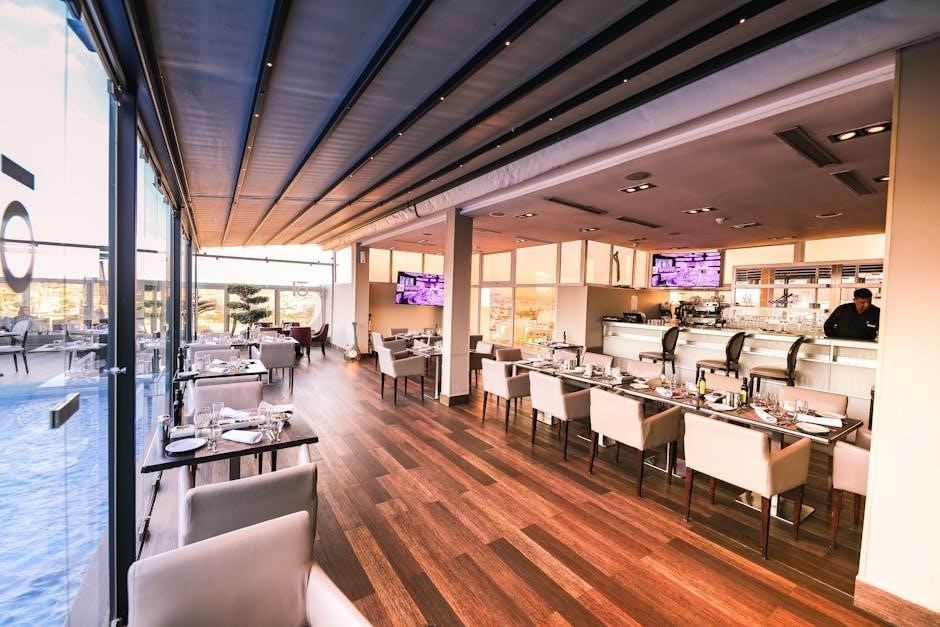
Understanding PAL Pool Lighting Components
The PAL pool lighting system consists of key components, including the power supply, transformer, wiring, and LED lights. Understanding each part ensures proper functionality and safe operation. The power supply provides the necessary voltage, while the transformer steps down the voltage for the LEDs. Wiring connects all components, and the LED lights offer energy-efficient illumination. Familiarizing yourself with these elements helps in diagnosing and resolving issues effectively. Proper installation and maintenance of these components are crucial for optimal performance and longevity. Always refer to the user manual for specific component details and compatibility.
2.1. Overview of Components
Understanding the components of your PAL pool lighting system is crucial for effective troubleshooting. The system comprises several key elements: the transformer, which safely steps down the voltage; LED drivers that regulate power to the lights; and the power supply unit, ensuring a stable energy delivery. The wiring connects all these components, while the bulbs or LEDs provide the actual illumination. Control systems, including Wi-Fi modules, allow for automation and remote adjustments. Additionally, niche installation hardware secures the lights underwater, and remote controls offer convenient operation. Each part is essential for the overall functionality of the system. Familiarizing yourself with these components helps in quickly identifying and resolving issues. Regular maintenance and understanding of each part’s role ensure optimal performance and extend the system’s lifespan. This knowledge is fundamental for any troubleshooting process.
2.2. Identifying Key Parts
To effectively troubleshoot your PAL pool lighting system, it’s essential to identify and locate its key components. The transformer is typically located near the power supply and converts high voltage to low voltage for safe operation. LED drivers, often found near the lights, regulate power delivery to ensure consistent brightness. The power supply unit, usually housed in a protective enclosure, distributes energy to the system. Wiring, including the main cable connecting components, should be inspected for damage or corrosion. Bulbs or LEDs are installed in underwater niches, while control systems like Wi-Fi modules or remotes enable adjustments. Niche hardware secures the lights in place, and installation components like gaskets prevent water ingress. Understanding the location and function of each part simplifies diagnostics and repairs, ensuring quick identification of potential issues.

Power Supply Issues
Power supply issues often stem from transformer failure or voltage mismatches. Check for flickering lights, shutdowns, or dimming. Ensure the transformer is functioning correctly and voltage levels are appropriate. Inspect the power supply unit for wear or corrosion. Addressing these problems promptly prevents serious damage and ensures reliable operation.
3.1; Checking Voltage
Checking voltage is a critical step in diagnosing power supply issues. Ensure the system is turned off before testing. Use a multimeter to measure voltage at the transformer and driver. For PAL systems, typical voltage ranges are 12V DC or 24V DC, depending on the model. Compare readings with the manufacturer’s specifications, which can be found in the user manual. Low or high voltage may indicate a faulty transformer or wiring issue. If voltage is inconsistent, inspect the transformer and wiring for damage or corrosion. Ensure all connections are secure and free from debris. If voltage readings are outside the recommended range, contact a professional to address the issue. Always prioritize safety when working with electrical components near water.
3.2. Inspecting the Transformer
Inspecting the transformer is essential for identifying power supply issues. Locate the transformer, typically found near the pool equipment, and ensure it is securely mounted. Visually examine for signs of damage, rust, or corrosion. Check the transformer’s output terminals for tight connections and ensure all wires are properly secured. Look for burn marks or discoloration, which may indicate overheating or short circuits. Verify the transformer’s rating matches the system’s requirements, as specified in the PAL Lighting manual. If you find any damage or loose connections, disconnect power immediately and contact a professional. The transformer is critical for converting voltage to the appropriate level for your pool lights, so any issues here can directly affect system performance. Regular inspections can prevent unexpected failures and ensure safe operation.
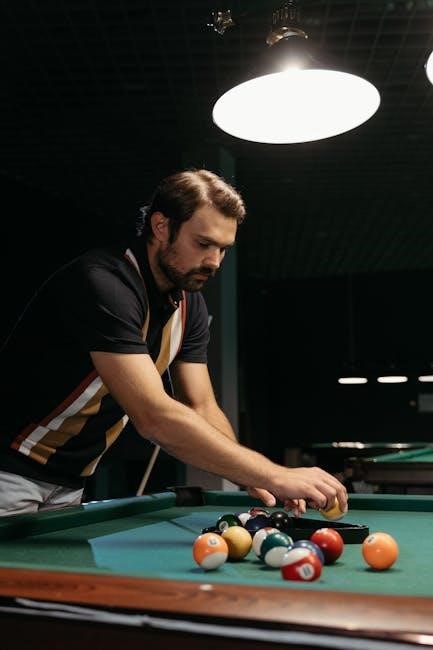
Wiring and Connections
Proper wiring and connections are crucial for your PAL pool lighting system. Regularly inspect cables for frays or damage and ensure all connections are secure. Loose connections can cause malfunctions, while improperly installed wires may lead to safety hazards. Always follow the manufacturer’s guidelines for wiring configurations and ensure compliance with local electrical codes. If you suspect wiring issues, consult the manual or a licensed electrician to avoid further complications. Regular checks can prevent unexpected outages and ensure smooth operation of your pool lighting system.
4.1. Inspecting Cables
Inspecting cables is a critical step in troubleshooting PAL pool lighting systems. Begin by visually examining all cables for signs of damage, such as frays, cuts, or corrosion. Ensure all connections between the power supply, transformers, and lights are secure and free from moisture. Check for any signs of wear near connectors or splice points. If you find damaged cables, replace them immediately to prevent power interruptions or safety hazards. Use a multimeter to test for continuity or voltage drops, which can indicate faulty wiring. Pay special attention to areas exposed to water, as these are prone to corrosion. Regular cable inspections help prevent unexpected outages and ensure reliable operation of your pool lighting system. Always turn off the power before handling electrical components to avoid accidents. If you’re unsure about any aspect of the inspection, consult a licensed electrician for assistance. Properly maintained cables are essential for the safe and efficient functioning of your PAL pool lights. By addressing cable issues early, you can prevent more severe problems from developing. This step is vital for ensuring the longevity and performance of your lighting system. Regular inspections also help identify potential safety risks before they become critical. Always follow the manufacturer’s guidelines for cable replacement and maintenance to maintain warranty coverage and system integrity. Inspecting cables is a simple yet effective way to keep your pool lighting system running smoothly.
4.2. Testing Connections
Testing connections is essential for ensuring the proper functioning of your PAL pool lighting system. Begin by turning off the power supply to avoid electrical hazards. Use a multimeter to verify voltage at key connection points, such as the transformer and light fixtures. Check for continuity between wires to identify any breaks or short circuits. Inspect all connectors for tightness and signs of corrosion or damage. If a connection appears loose or corroded, clean or replace it as needed; Pay particular attention to the transformer connections, as they are critical for power distribution. If you find any faulty connections, repair or replace them promptly to restore system performance. Always follow safety guidelines when working with electrical systems near water. If unsure about any aspect of testing connections, consult a licensed electrician to ensure everything is safe and functional. Properly tested connections are vital for reliable pool lighting operation.
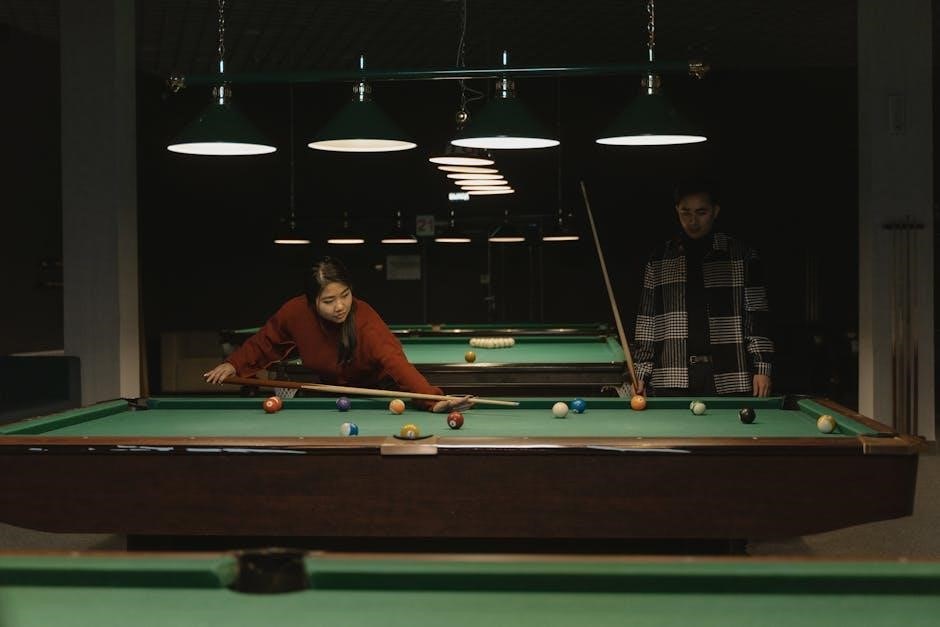
Control Systems
PAL pool lighting systems feature advanced control options, including automation and manual overrides. Automation allows scheduling and color adjustments, while manual controls enable direct operation. Ensure Wi-Fi connectivity for remote adjustments via apps, enhancing convenience and customization for optimal lighting experiences.
5.1. Automation Features
PAL pool lighting systems offer advanced automation features, allowing users to control lighting settings through smart devices. Automation enables scheduling, color changes, and brightness adjustments remotely. Ensure proper Wi-Fi connectivity and check the app for firmware updates. If automation fails, restart the system or reset the Wi-Fi module. Verify that all devices are synced correctly, especially when integrating with other pool systems. Use the app to monitor and adjust settings, ensuring smooth operation. Regularly update software to access new features and improve performance. Automation enhances convenience and customization, but issues like connectivity loss or syncing problems may require troubleshooting steps outlined in this manual.
5.2. Manual Override
For situations where automation fails, PAL pool lighting systems offer a manual override feature. Locate the S1 button on the driver or control panel to toggle lights on/off. Pressing this button once turns the lights on, while pressing it again turns them off. Ensure the power supply to the driver is active before using the manual override. If the lights do not respond, check connections and wiring for integrity. Additionally, verify that the transformer is functioning correctly and providing the required voltage. If manual control still doesn’t work, reset the system by turning off the power, waiting 30 seconds, and turning it back on. This feature ensures you can operate the lights even when automation or remote connectivity fails. Always refer to the control panel or driver for the S1 button location, as it may vary by model.
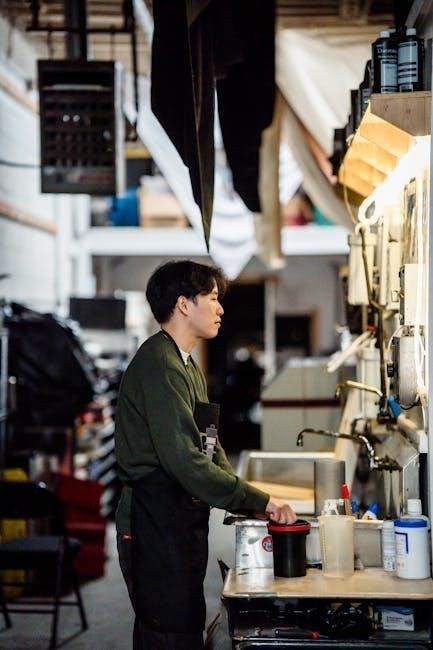
Bulb and LED Issues
Identify issues like flickering, dimming, or non-functioning bulbs/LEDs. Check connections, replace faulty bulbs, and inspect LED drivers. Ensure proper installation and power supply to resolve lighting problems effectively.
6;1. Replacing Bulbs
Replacing bulbs in your PAL pool lighting system is a straightforward process when done correctly. Always ensure the power supply is turned off before attempting any replacement to avoid electrical hazards. Remove the old bulb by gently twisting it counterclockwise and pulling it out. Inspect the socket for any debris or corrosion and clean if necessary. Install the new bulb, ensuring it is compatible with your system, and secure it by twisting it clockwise until it clicks. Turn the power back on and test the light to confirm it is functioning properly. If the issue persists, consult the manual or contact a professional for further assistance. Regular bulb replacements can prevent dimming or flickering issues, ensuring your pool remains well-lit and visually appealing. Always follow safety guidelines when handling electrical components near water.
6.2. Checking LED Drivers
Checking the LED drivers in your PAL pool lighting system is essential for ensuring proper illumination and preventing premature failure. Start by turning off the power supply to the system. Locate the LED driver, typically found near the transformer or power supply unit. Use a multimeter to verify the output voltage matches the specifications for your PAL lights. Inspect the driver for signs of damage, such as burn marks or overheating. Check all connections to ensure they are secure and free from corrosion. If the driver is faulty, replace it with a compatible model, such as the PAL PCR-1Z or PCR-2Z, depending on your system’s requirements. Always refer to the manual for specific instructions, as incorrect installation can damage the lights or void the warranty; Regular inspection of the LED drivers can prevent dimming or flickering issues and extend the lifespan of your pool lighting system. If unsure, consult a professional to avoid electrical hazards. Proper maintenance ensures optimal performance and safety for your pool lighting setup.

Niche and Installation Problems
Niche and installation issues are common in PAL pool lighting systems, often leading to improper light alignment or water leakage. Start by inspecting the niche for damage or misalignment. Ensure the light assembly is securely fastened and properly seated within the niche. Verify that all screws or clips are tightened evenly to avoid uneven positioning. Check for gaps between the light and niche, which can cause water ingress. Inspect the hook placement on the light assembly to ensure it aligns with the niche slot. If the light is not fitting correctly, refer to the installation manual for specific instructions. For nicheless models, like the 64-PAL-RAL, ensure the mounting hardware is correctly installed and sealed. If issues persist, consider consulting a professional to avoid further damage or electrical hazards. Proper installation is crucial for both functionality and safety, ensuring your pool lighting performs optimally and remains secure. Regular inspections can prevent major issues and extend the system’s lifespan.
Color and Brightness Adjustments
Adjusting the color and brightness of your PAL pool lights is straightforward but may require troubleshooting if issues arise. If the color isn’t changing or brightness isn’t adjusting, check the remote or app connection. Ensure the Wi-Fi module is properly installed and synced with the system. Verify that the LED drivers are functioning correctly, as faulty drivers can prevent color or brightness changes. Refer to the user manual for specific instructions on adjusting settings via the control panel or app. If using automation, ensure it’s properly configured. For manual adjustments, use the designated buttons or touch controls. If issues persist, reset the system by turning it off and on or updating the firmware. Always ensure the system is on the correct mode for color and brightness adjustments. If problems remain, consult a professional or contact PAL support for assistance.
Remote and App Connectivity
Troubleshooting remote and app connectivity for PAL pool lighting involves checking the Wi-Fi module and ensuring it is properly synced with the system. If the app cannot control the lights, verify that the Wi-Fi module is installed correctly and that the app is updated to the latest version. Restart the power supply to the lighting system and retry connectivity. If the issue persists, reset the Wi-Fi module by pressing the reset button located near the module. Ensure the remote control is paired correctly with the system by following the pairing instructions in the user manual. If the lights do not respond to the remote or app, check for interference from other devices or ensure the system is in the correct mode. Contact PAL support if connectivity issues remain unresolved.
Safety Precautions
When troubleshooting PAL pool lighting, always prioritize safety to avoid electrical hazards. Ensure the power supply is turned off before performing any maintenance or repairs. Never work on wet surfaces or while in contact with water. Use insulated tools to prevent electric shock. Always disconnect the power supply before inspecting or replacing components like bulbs, drivers, or wiring. Ensure the system is properly grounded to prevent electrical accidents. Avoid submerging electrical components unnecessarily, and keep the area around the pool niche dry during repairs. If you are unsure about any procedure, consult a licensed electrician or pool technician. Regularly inspect cables and connections for damage or corrosion, and replace them if necessary. Follow all local and national electrical codes to ensure compliance and safety. Always refer to the manufacturer’s guidelines for specific safety recommendations tailored to your PAL pool lighting system.
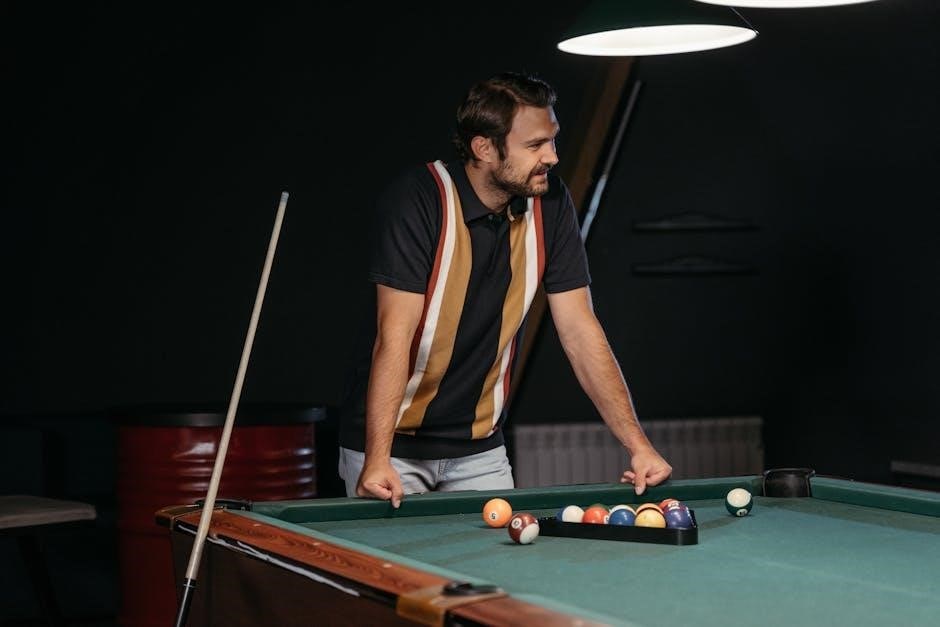
Diagnostics and Error Codes
Diagnostics and error codes are essential for identifying issues in PAL pool lighting systems. Error codes like “three white flashes” indicate synchronization problems between lights and controllers. To diagnose, press and hold the receiver’s button while cycling power to display error codes. For example, “two red flashes” may signal a power supply issue. Consult the manual for specific code meanings. To clear codes, press and hold the “S” button on the transmitter for 3 seconds. Ensure all lights are powered on during diagnostics. If codes persist, check connections and wiring for damage. Advanced diagnostics may require a multimeter to test voltage levels at drivers. Always refer to the manual for detailed code explanations and solutions. Regular diagnostics help prevent minor issues from becoming major problems.
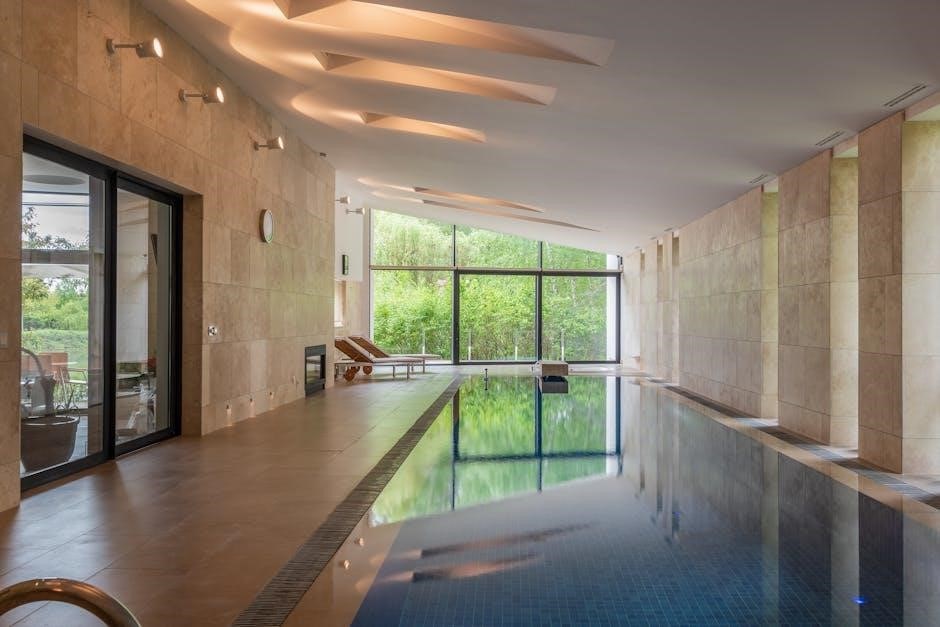
Advanced Troubleshooting
Advanced troubleshooting involves addressing complex issues that basic methods cannot resolve. Start by testing voltage at the LED drivers using a multimeter to ensure it matches the specified 12V DC. If lights flash erratically, check for loose connections or corrosion in the wiring. For synchronization issues, reset the system by turning off power, holding the transmitter’s “S” button for 5 seconds, and cycling power again. If multiple lights malfunction, inspect the transformer and power supply for overload or damage. For Wi-Fi connectivity problems, restart the router and ensure the PAL app is updated. If issues persist, perform a factory reset on the driver by pressing the small reset button for 10 seconds. Always consult the manual for specific procedures, and contact PAL support if problems remain unresolved. Regular advanced checks can prevent system-wide failures.

When to Call a Professional
If you encounter persistent issues beyond basic troubleshooting, it’s essential to consult a licensed electrician or PAL-certified technician. This is especially true for complex problems like faulty transformers, damaged LED drivers, or synchronization issues across multiple lights. If water has entered the lighting niche or electrical components, immediate professional intervention is required to prevent safety hazards. Additionally, if you notice consistent voltage fluctuations or overloaded circuits, a professional should assess and repair the system. For advanced diagnostics or warranty-related issues, contact PAL Lighting support for authorized service. Always prioritize safety when dealing with electrical systems near water, and avoid attempting repairs beyond your expertise. A professional will ensure compliance with safety standards and resolve issues efficiently.
Preventive Maintenance
Regular preventive maintenance is crucial to ensure the longevity and optimal performance of your PAL pool lighting system. Start by inspecting the power supply and wiring for any signs of wear or damage. Clean the lighting fixtures and lenses to maintain brightness and color accuracy. Check the niche for proper sealing to prevent water ingress, which can damage electrical components. Inspect LED drivers for consistent output and replace them if necessary. Additionally, test remote and app connectivity to ensure smooth operation. Schedule annual professional inspections, especially for underwater lights, to identify potential issues early. By following these steps, you can prevent major breakdowns, reduce repair costs, and extend the lifespan of your PAL pool lighting system. Regular maintenance also ensures safety and consistent illumination, keeping your pool area inviting and well-lit.
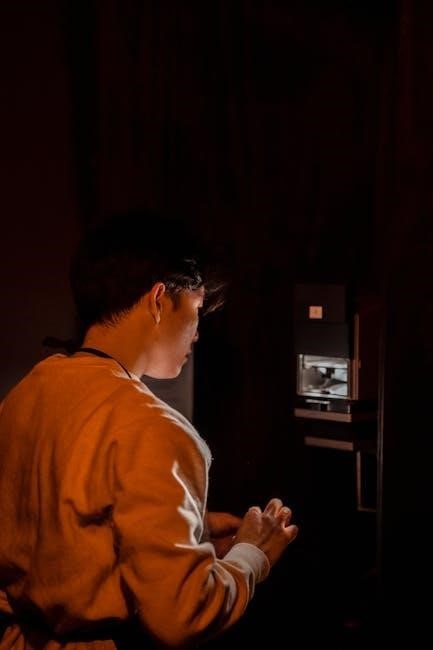
Leave a Reply
You must be logged in to post a comment.